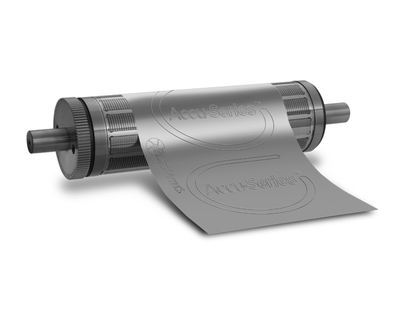With increasing pressure on converters to reduce waste and cut costs, manufacturer of precision die tooling, RotoMetrics, has launched a new range of flexible dies.
First seen at Labelexpo in Brussels last year, the new Accu-Series is defined by four distinct types that allow converters to choose the most appropriate for their specific requirements. The four types are: AccuSmart – the economical choice for most of today’s short and medium run lengths; AccuPrime – the choice for those needing to convert a wider range of substrates; AccuStar Ultra- Film – for those needing high precision on today’s challenging synthetics; and AccuStar Life – for those converting abrasive materials.
Rethink required
The introduction of the Accu-Series marks a major rationalisation of the RotoMetrics’ range of flexible dies. Following the acquisition of Gerhardt in 2011, the company had a portfolio of 11 different flexible die models with 28 variations – a bewildering choice for manufacturer and converter alike, and one that soon elicited a rethink.
According to European managing director Peter Emerson, ‘It was a major undertaking, but one that has brought very positive feedback from the market place. Just as printers and converters constantly monitor their equipment to ensure maximum productivity, so we, as a manufacturing supplier, need to be responsive to changes in demand.’
The company is keen to point out that the chrome coating it applies to its flexible dies is based on the knowledge and experience it has acquired over decades of chrome plating its solid CNC tools. This has been refined to give the Accu-Series flexible chrome that offers excellent durability, increased life and wear resistance. Mr Emerson commented, ‘It is tried and tested, and while we now see our European competitors introducing the chrome process, we also offer induction hardening, core hardening on our solid dies, and laser hardening on our flexible range.’ The key to the process of successful rationalisation was establishing the core requirements of the customers.
By reducing much of the complexity that bespoke dies require, and focusing on the key elements of die life, blade geometry, and speed, the company has created what it believes is a simplified choice for converters that responds exactly to the majority of their needs. Prime advantages are lower production costs in the manufacturing process, which translate into faster delivery at highly competitive prices for the converters.
Market drivers
According to Mr Emerson, there are three main drivers in today’s market that have exerted a major influence on RotoMetrics’ thinking and product development: the increasing number of digital presses in the narrow web sector; the rise in popularity of thin filmic substrates for printed packaging; and the growing strength of competition in the global market. The use of digital press technology to satisfy the demand for ever shorter run lengths effectively redefined the production and delivery chain for suppliers.
Faster turnaround to cope with more frequent job changes meant that traditional practices needed to be rethought. By concentrating on lean manufacturing techniques and workflow optimisation, the company achieved ISO 9001 and ISO 14001 across all its manufacturing plants in 2013, effecting the most streamlined ordering and production process in the world .
The cost and waste savings offered by the use of thin films for face stocks and liners is proving too tempting for the printed packaging industry to resist, but these materials pose problems for die tooling with blade geometry and tighter tolerance levels. In response, the company developed the new AccuStar UltraFilm, which meets the demands of converting 19 and 23 micron films, making it the most precise flexible die available.
To meet the rise in competition around the world, where price is often the deciding factor in converters’ purchasing habits, RotoMetrics took a more holistic view at ‘whole life’ costs with its new AccuStar Life flexible die. Following extensive field tests it proved that, in a commercial production environment, the Accu-Star Life offers more revolutions per $/£/€ or any other currency than its competitors, and therefore makes a better case for investment.
‘Testing and customer involvement were key elements in the development of the new Accu-Series,’ said Mr Emerson, ‘By listening to their comments and adapting the designs as we went along, we believe the new flexible dies deliver the right combination of price and performance for our customers, and provide the functionality and capability they asked us for. We see the process as ongoing – whichmeans we’ll keep listening!’






